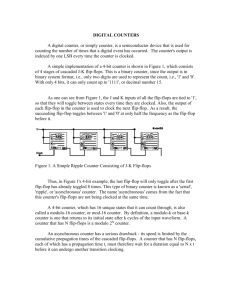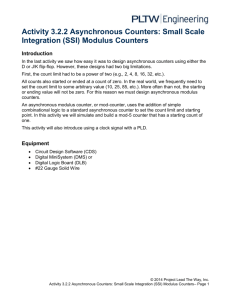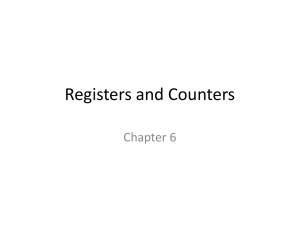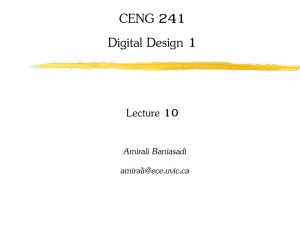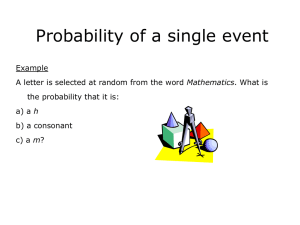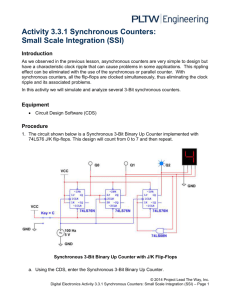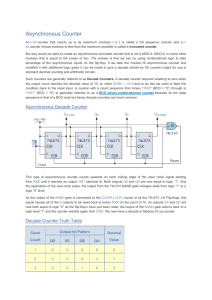Asynchronous Counters
advertisement
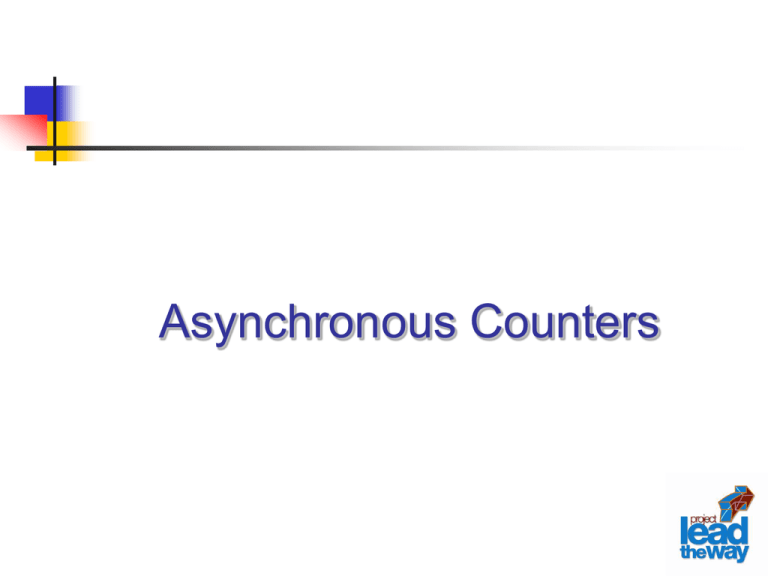
Asynchronous Counters Lecture Overview Classifications of Counters Definitions Asynchronous Counter… J – K Flip Flops D Flip Flops Up Counters Down Counters Truncated Counters Design Example Classifications of Counters Asynchronous Counters Only the first flip-flop is clocked by an external clock. All subsequent flip-flops are clocked by the output of the preceding flip-flop. Asynchronous counters are slower than synchronous counters because of the delay in the transmission of the pulses from flip-flop to flip-flop. Asynchronous counters are also called ripplecounters because of the way the clock pulse ripples it way through the flip-flops. Classifications of Counters Synchronous Counters All flip-flops are clocked simultaneously by an external clock. Synchronous counters are faster than asynchronous counters because of the simultaneous clocking. Synchronous counters are an example of state machine design because they have a set of states and a set of transition rules for moving between those states after each clocked event. States / Modulus / Flip-Flops The number of flip-flops determines the count limit or number of states. (STATES = 2 # of flip flops) The number of states used is called the MODULUS. For example, a Modulus-12 counter would count from 0 (0000) to 11 (1011) and requires four flip-flops (16 states - 12 used). 1 Bit Asynch-Counter / Modulus 2 2 Bit Asynch-Counter / Modulus 4 3 Bit Asynch-Counter / Modulus 8 The Ripple Effect… Q0 Q1 Q2 Ripple Effect…The Problem Q0 Q1 Q2 3 4 2 0 D Flip-Flop… Nothing Special About J-K Six Examples 1. Modulus 4 Up Counter with Negative Edge Triggered Flip-Flops 2. Modulus 4 Down Counter with Negative Edge Triggered Flip-Flops 3. Modulus 4 Up Counter with Positive Edge Triggered Flip-Flops 4. Modulus 4 Down Counter with Positive Edge Triggered Flip-Flops 5. Truncated Counter 6. Counter Design Up Counter w/ Negative Edge Flip-Flops Down Counter w/ Negative Edge Flip-Flops Up Counter w/ Positive Edge Flip-Flops Down Counter w/ Positive Edge Flip-Flops Truncating the Count… Modulus 6 Modulus-6 Counter Asynchronous Counter Design Steps 1. Select Type 2. Select Flip-Flop Type 3. Up or Down Modules J-K or D Positive Edge Trigger (PET) or Negative Edge Trigger (NET) Determine Number of Flip-Flops (2# Flip-Flop Modules) Asynchronous Counter Design Steps 5. Design Basic Counters 6. Same polarity for down counters: Q PET or Q NET Opposite polarity for up counters: Q NET or Q PET Design Limits Logic Input to logic is count that is one past the end of sequence. Design Example 1. Select Type 2. Select Flip-Flop Type 3. Up or Down Modules MOD – 14 (0..13) J-K or D Positive Edge Trigger (PET) or Negative Edge Trigger (NET) Determine Number of Flip-Flops 4 Flip-Flop 16 (2# Flip-Flop Modules) 2 Design Example 5. Design Basic Counters 6. Same polarity for down counters: Q PET or Q NET Opposite polarity for up counters: Q NET or Q PET Design Limits Logic Input to logic is count that is one past the end of sequence. Limit 13+1 = 14 (1110) Design Example…Solution

![Lesson 8_3–Synchronous Counters[1]](http://s2.studylib.net/store/data/005727557_1-25e5d6e99f500ad17373ec48380a1b3c-300x300.png)

